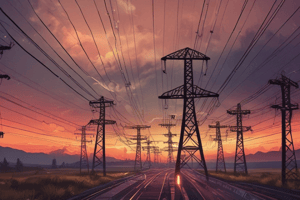Podcast
Questions and Answers
What is the primary purpose of transmission lines in the electrical power system?
What is the primary purpose of transmission lines in the electrical power system?
- To transport high-voltage electricity from power plants to substations (correct)
- To convert electrical energy into other forms of energy
- To supply electricity directly to consumers
- To regulate the voltage of electricity for distribution purposes
Which of the following energy sources is NOT commonly used for generating electrical power?
Which of the following energy sources is NOT commonly used for generating electrical power?
- Hydro
- Petroleum (correct)
- Coal
- Solar
What is the main function of generators in the generation of electrical power?
What is the main function of generators in the generation of electrical power?
- To store excess electricity
- To convert electrical energy into mechanical energy
- To convert kinetic, thermal, or chemical energy into electrical energy (correct)
- To regulate the voltage of electricity
Why are power plants using alternating current (AC) with high voltage for transmission purposes?
Why are power plants using alternating current (AC) with high voltage for transmission purposes?
In the electrical power system, what is the final stage before electricity reaches consumers?
In the electrical power system, what is the final stage before electricity reaches consumers?
Which component of the electricity distribution process is most responsible for energy loss?
Which component of the electricity distribution process is most responsible for energy loss?
What is the main challenge faced by the electrical power industry according to the text?
What is the main challenge faced by the electrical power industry according to the text?
How does efficiency in electrical power systems impact energy loss?
How does efficiency in electrical power systems impact energy loss?
What role do lighting systems and heating systems play in consuming electricity?
What role do lighting systems and heating systems play in consuming electricity?
In the context of electricity transmission, what is meant by 'levels safe for everyday household use'?
In the context of electricity transmission, what is meant by 'levels safe for everyday household use'?
Flashcards are hidden until you start studying
Study Notes
Exploring Electrical Power: A Comprehensive Guide
Electrical power is the lifeblood of our modern world, enabling the illumination, communication, and convenience that shape our lives. To grasp its many facets, let's delve into the key components of its journey from generation to our outlets: distribution, transmission, and consumption.
Generating Electricity
Electrical power originates from a variety of sources, including coal, natural gas, nuclear, hydro, solar, wind, and geothermal power. These sources convert kinetic, thermal, or chemical energy into electrical energy through devices known as generators, which are typically driven by steam from boilers, water from dams, or wind turbines.
Transmission
High-voltage electricity journeys from power plants to substations via transmission lines, which can span hundreds of miles. These lines are constructed to minimize energy loss and are often elevated, reducing the risk of damage from weather, animals, or human interference. Power plants typically use alternating current (AC) with a high voltage (up to 765 kV in the United States) to minimize the energy lost through transmission, which is then converted to lower voltages for distribution.
Distribution
Lower-voltage electricity is then sent to consumers through distribution lines, which can be overhead or buried underground. Distribution lines are managed by utility companies like power co-ops or municipalities and deliver energy to homes, businesses, and other buildings. The voltage of the electricity is further reduced to levels safe for everyday household use (120 V or 240 V) before it enters homes or businesses.
Consumption
Electrical appliances, lighting, and heating systems are just a few examples of devices that consume electricity. These devices transform electrical energy into other forms, such as light, heat, or mechanical work, allowing us to perform tasks and fulfill our daily needs.
Efficiency and Loss
Efficiency describes the ratio of output power to input power and is an important metric in electrical power. As electricity travels from generation to distribution, a small amount of energy is inevitably lost to heat and resistance in wires and transformers. Approximately 6% of power is lost during transmission and distribution, emphasizing the necessity of reducing energy waste.
Advancements and Challenges
Recent advancements in renewable energy, energy storage, and smart-grid technology have expanded our options for generating and distributing electricity. For example, advances in battery storage technology have enabled the use of renewable energy sources, like solar and wind power, to be stored and released as needed.
One of the challenges of the electrical power industry is to reduce the environmental impact of energy production and to ensure that electricity is delivered reliably and affordably. As our global population grows, we must balance the need for energy with the imperative to reduce our carbon footprint.
In closing, electricity is a fundamental part of our daily lives, and its generation, transmission, and distribution are essential to our well-being, comfort, and prosperity. Understanding these processes helps us to appreciate the intricacies and challenges of providing a reliable, clean, and affordable energy supply.
Studying That Suits You
Use AI to generate personalized quizzes and flashcards to suit your learning preferences.




